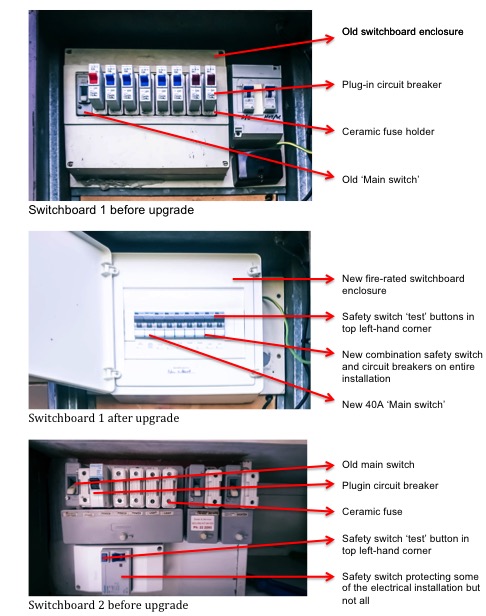fuses, circuit breakers and safety switches…what are they?
Every house and business is different. The switchboard from one premise to the next can look very different, although they are all fundamentally the same.
In this blog we’ll try to explain the common parts of a typical residential switchboard so you have a basic idea of what does what, which may come in handy if you ever experience a fault. In an upcoming blog we’ll cover some basic fault finding and troubleshooting tips.
The main switch when in the ‘off’ position will turn off all power to the property, except for perhaps an electric hot water system if it has it’s own main switch. In most cases the main switch is to the left of the switchboard but it can be in a different position in some older switchboards. This ‘master switch’ typically controls all circuits connected to lighting and power points, ovens, air conditioners and sheds, amongst other things. It is typically labelled ‘Main switch’ or ‘Main switch light & power‘. There may also be a ‘Main switch hot water’ or similar, for older electric hot water systems. These tend to operate independently as they are on a different tariff. Following the main switch are usually the individual circuits for lighting, power points etc. These are in no particular order.
Older switchboards will have ceramic fuses, or semi enclosed re-wireable fuse (SERF) as they are known. These allowed the occupant to re-wire the piece of fuse wire inside if it had blown.
The next progression is the miniature circuit breaker (MCB) as it’s technically called, or more commonly known as a circuit breaker. The purpose of a fuse or circuit breaker is to protect the cable installed in a property from overheating and melting from too much current flowing through it, which can lead to fires. They do not protect people from electrical hazards such as an electric shock.
A safety switch is a common term used to describe a Residual Current Device or RCD for short. It is called a safety switch because it is designed to reduce the risk of electric shock, electrocution or damage to people and property.
Many newer switchboards will have one safety switch protecting up to three circuits. Some slightly older switchboards may have one safety switch protecting more than three circuits, which was allowed under previous regulations. The problem with having numerous circuits protected by the one safety switch is potentially having no lighting or power until the issue is resolved. Spreading your various circuits between a number of safety switches reduces the impact of a fault.
Residual current circuit breaker with over current protection (RCBO’s) is simply a circuit breaker and safety switch built into one. They are typically used on just one circuit whereas a stand-alone safety switch can protect multiple circuits. Both installation methods provide the same level of protection. When upgrading a switchboard, Luke prefers to use RCBO’s as they take up less room, reduce the impact of a fault, and if there is ever a problem, identifying and fixing the problem is often quicker and therefore cheaper for the customer.
A description of how safety switches work is outlined in my previous blog, Safety switches – what are they are why are they important.
Below are some pictures of these different types of switchboard components.

Below are some before and after pictures of switchboard upgrades Luke has done recently.
If you have an older switchboard and want to discuss your options to make it safer please feel free to contact us.

